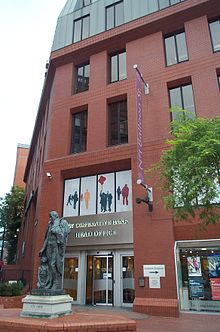Credit unions and cooperative banking
Credit unions are cooperative financial institutions that are owned and controlled by their members. Credit unions provide the same financial services as banks but are considered not-for-profit organizations and adhere to cooperative principles. Credit unions originated in mid-19th century Germany through the efforts of pioneers Franz Hermann Schulze-Delitzsch and Friedrich Wilhelm Raiffeisen. The concept of financial cooperatives crossed the Atlantic at the turn of the 20th century, when the caisse populaire movement was started by Alphonse Desjardins in Quebec, Canada. In 1900, from his home in Levis, he opened North America's first credit union, marking the beginning of the Mouvement Desjardins.[33] Eight years later, Desjardins provided guidance for the first credit union in the United States,[34] where there are now about 7,950 active status federally insured credit unions, with almost 90 million members and more than $679 billion on deposit.[35] While they have not taken root so deeply as in Ireland, credit unions are also established in the UK. The largest are work-based, but many are now offering services in the wider community. The Association of British Credit Unions Ltd (ABCUL) represents the majority of British Credit Unions. British Building Societies developed into general-purpose savings & banking institutions with "one member, one vote" ownership and can be seen as a form of financial cooperative (although nine 'de-mutualised' into conventionally owned banks in the 1980s & 1990s). The UK Co-operative Group includes both an insurance provider CIS and the Co-operative Bank, both noted for promoting ethical investment. Other important European banking cooperatives include

he Credit Agricole in France, Migros and Coop Bank in Switzerland and the Raiffeisen system in many Central and Eastern European countries. The Netherlands, Spain, Italy and various European countries also have strong cooperative banks. They play an important part in mortgage credit and professional (i.e. farming) credit.[citation needed] Cooperative banking networks, which were nationalized in Eastern Europe, work now as real cooperative institutions. A remarkable development has taken place in Poland, where the SKOK (Spoldzielcze Kasy Oszczednosciowo-Kredytowe) network has grown to serve over 1 million members via 13,000 branches, and is larger than the country’s largest conventional bank.[citation needed] In Scandinavia, there is a clear distinction between mutual savings banks (Sparbank) and true credit unions (Andelsbank).[citation needed] The oldest cooperative banks in Europe, based on the ideas of Friedrich Raiffeisen, are joined together in the 'Urgenossen'.In financial economics, a financial institution is an institution that provides financial services for its clients or members. Probably the most important financial service provided by financial institutions is acting as financial intermediaries. Most financial institutions are regulated by the government. Broadly speaking, there are three major types of financial institutions:[1][2] Depositary Institutions : Deposit-taking institutions that accept and manage deposits and make loans, including banks, building societies, credit unions, trust companies, and mortgage loan companies Contractual Institutions : Insurance companies and pension funds; and Investment Institutes : Investment Banks, underwriters, brokerage firms.